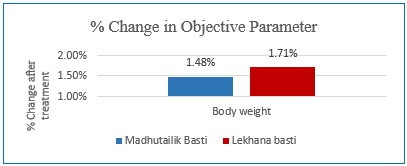Comparative study to evaluate the efficacy of Madhutailik Basti in comparison to Lekhana Basti in the management of Sthaulya (Obesity)
DOI:
https://doi.org/10.21760/jaims.8.10.8Keywords:
Sthaulya, Obesity, Meda Dhatu, Madhutailik Basti, Lekhana BastiAbstract
Obesity is a chronic disease, increasing globally and is characterised by excess body fat. As a preventable cause of death, obesity is second only to smoking. Obesity is a potent co-morbid risk factor for mortality and morbidity, if it remains untreated. It emerges as an important health problem in India. It is estimated that 31.6 million Indians are obese, specially abdominally obese. Obesity is the primary driver of non-communicable diseases, like diabetes, cardiovascular diseases, disabilities like osteoarthritis and even cancer. In Ayurvedic texts, Sthaulya is categorized as Santarpanjanya Roga. Lekhana Basti is a well-known treatment for Sthaulya in Ayurveda and lot of research work has done in the past but it is not suitable for all Sthula Purusha because of its Tikshana nature. Many complications like abdominal pain or pricking pain in anal region, bleeding per rectum were observed practically. In the present study, Lekhana Basti and Madhutailik Basti were selected for Sthaulya. Sthaulya is Kapha-Meda Pradhana Vyadhi with Medavritta Vata. The drugs of Madhutailik Basti have Ushna Virya and Kapha Vatahara property. So, it regulates the Samana Vayu and restores the “Jatharagni” to normal, while also activating the Vyana Vayu to break the Srotosanga and synergize the activity of Madhutailik Basti at the cellular level. Thus, it helps to break the pathogenesis of the disease. Considering the above facts case study was planned to evaluate the comparative effectiveness of Madhutailik Basti with Lekhana Basti in the management of Sthaulya (obesity) in 60 clinically diagnosed and confirmed cases of Sthaulya from OPD of Ch. Brahm Prakash Ayurved Charak Sansthan, Khera Dabar, Delhi.
Downloads
References
Flier JS, Maratos-Flier E. Biology of obesity. In: Jameson JL, Fauci AS, Kasper DL, Hauser SL, Longo DL, Loscalzo J, editors. Harrison’s Principles of Internal Medicine. 17th ed. New York: McGraw Hill; 2008. p. 462.
Flier JS, Maratos-Flier E. Biology of obesity. In: Jameson JL, Fauci AS, Kasper DL, Hauser SL, Longo DL, Loscalzo J, editors. Harrison’s Principles of Internal Medicine. 17th ed. New York: McGraw Hill; 2008. p. 463.
Ahirwar R, Mondal PR. Prevalence of obesity in India: A systematic review. Diabetes Metab Syndr. 2019 Jan-Feb;13(1):318-321. DOI: 10.1016/j.dsx.2018.08.032. PMID: 30641719.
Pandey KS, Chaturvedi G. Charak Samhita; savimarsh vidiyotini hindi vyakhya (first part). Reprint 2020. Varanasi: Chaukhambha Bharati Academy; Sutra Sthana 21/3, p. 355.
Pandey KS, Chaturvedi G. Charak Samhita; savimarsh vidiyotini hindi vyakhya (first part). Reprint 2020. Varanasi: Chaukhambha Bharati Academy; Sutra Sthana 21/9, p. 357.
Pandey KS, Chaturvedi G. Charak Samhita; savimarsh vidiyotini hindi vyakhya (first part). Reprint 2020. Varanasi: Chaukhambha Bharati Academy; Sutra Sthana 20/17, p. 352.
Pandey KS, Chaturvedi G. Charak Samhita; savimarsh vidiyotini hindi vyakhya (first part). Reprint 2020. Varanasi: Chaukhambha Bharati Academy; Sutra Sthana 23/6, p. 379.
Srivastava S. Sharangadhar Samhita of Acharya Sharangdhar "Jiwanprada" hindi commentary. Reprint 2017. Varanasi: Chaukhambha Orientalia; Uttar Khanda ch.6, p.387/29-31.
Pandey KS, Chaturvedi G. Charak Samhita; savimarsh vidiyotini hindi vyakhya (second part). Reprint 2020. Varanasi: Chaukhambha Bharati Academy; Sidhi Sthana 2/14, p. 902.
Shastri KA. Jvararogadhikar 5/1286-1287. Bhaisjya Ratnavali. Varanasi: Chaukhambha Prakashana; 2018. p. 85-186.
Nagar S. Comparative study to evaluate the efficacy of Madhudaka and Manda in the management of Sthaulya (Obesity) [thesis]. New Delhi: CBPACS; 2020. p. 77.
Skalicky J, Muzakova V, Kandar R, et al. Evaluation of oxidative stress and inflammation in obese adults with metabolic syndrome. Clin Chem Lab Med. 2008;46:499–505.















